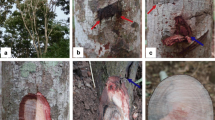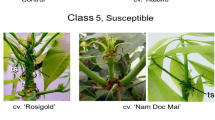Abstract
Mango is amongst the most exported fruits worldwide and the mango tree has been cultivated in many countries with tropical and subtropical climates. Currently, Ceratocystis wilt caused by Ceratocystis fimbriata is among the most important diseases on mango tree. Planting of resistant genotypes is the best strategy for disease control. In the selection of resistant plants a highly aggressive isolate should be used in inoculations under controlled conditions. Thus, the objective of this study was to evaluate whether there are differences in aggressiveness among isolates of C. fimbriata obtained from diseased mango trees in Brazil. Before inoculation, five randomly selected isolates were tested for sporulation and mycelial growth in different culture media in order to select the best conditions for inoculum production. Twenty-four isolates from the States of São Paulo, Rio de Janeiro, Minas Gerais and Mato Grosso do Sul were inoculated in the susceptible mango cultivar Espada. Subsequently, the four most aggressive isolates were inoculated in other five different mango cultivars. The culture media MEA provided the best levels of sporulation and mycelial growth for four of the five tested isolates. Isolates SEMG1-1 from Minas Gerais and SESP8-3 from São Paulo were the most aggressive. The response of cultivars to the most aggressive isolates tested in the present work varied from highly resistant to highly susceptible, ‘Ubá’ being the most resistant regardless of the isolate tested. These results demonstrate that there are significant differences in aggressiveness among C. fimbriata isolates from mango in Brazil, as well as cultivar × isolate interaction.


Similar content being viewed by others
References
Al Adawi, A. O., Deadman, M. L., Rawahi, A. K., Maqbali, Y. M., Al Jahwari, A. A., Ak Saadi, B. A., Al Amri, I. S., & Wingfield, M. J. (2006). Aetiology and causal agents of mango sudden decline disease in Sultanate of Oman. European Journal of Plant Pathology, 116, 247–54.
Baker, C. J., Harrington, T. C., Kraus, U., & Alfenas, A. C. (2003). Genetic variability and host specialization in the Latin American clade of Ceratocystis fimbriata. Phytopathology, 93, 1274–1284.
Borja, D. C., Caycedo, J. E. L., & Ríos, J. A. L. (1995). El secamiento de los citricos em la zona cafetera central. Cenicafé Avances Tecnicos, 212, 1–8.
CAB International. Ceratocystis fimbriata (original text prepared by T.C. Harrington) (2005). In Crop Protection Compendium. CAB International, Wallingford, UK.
Cunha, G. A. P., Pinto, A. C. Q., & Ferreira, F. R. (2002). Origem, Dispersão, Taxonomia e Botânica. In: GENÚ PJC, PINTO CAQ. (Ed. Tecs.). A cultura da mangueira. Brasília: Embrapa Informação Tecnológica, 1, 31–36.
Dhingra, O., & Sinclair, J. B. (1985). Basic Plant Pathology Methods. Boca Raton: CRC Press.
Engelbrecht, C. J. B., Harrington, T. C., Steimel, J., & Capretti, P. (2004). Genetic variation in Eastern North American and putatively introduced populations of Ceratocystis fimbriata f. sp. platani. Molecular Ecology, 13, 2995–3005.
Engelbrecht, C. J. B., Harrington, T. C., Alfenas, A. C., & Suarez, C. (2007). Genetic variation of populations of the cacao wilt pathogen, Ceratocystis cacaofunesta. Plant Patholology, 56, 923–933.
Fateh, F. S., Kazmi, M. R., Ahmad, I., & Ashraf, M. (2006). Ceratocystis fimbriata isolated from vascular bundles of declining mango trees in Sindh, Pakistan. Pakistan Journal of Botany, 38, 1257–1259.
Ferreira, F. A., Demuner, A. M., Demuner, N. L., & Pigatto, S. (1999). Murcha-de-Ceratocystis em eucalipto no Brasil. Fitopatologia Brasileira, 24, 284.
Ferreira, E. M., Harrington, T. C., Thorpe, D. J., & Alfenas, A. C. (2010). Genetic diversity and interfertility among highly differentiated populations of Ceratocystis fimbriata in Brazil. Plant Pathology, 59, 721–735.
Ferreira, M. A., Harrington, T. C., Alfenas, A. C., & Mitzubuti, E. S. G. (2011). Movement of genotypes of Ceratocystis fimbriata within and among Eucalyptus plantations in Brazil. Phytopathology, 101, 1005–1012.
Firmino, A. C., Tozze Júnior, H. J., & Furtado, E. L. (2012). First report of Ceratocystis fimbriata causing wilt in Tectona grandis in Brazil. New Disease Reports, 25, 24.
Food and Agriculture Organization of the United Nations. (2013). FAOSTAT: Agricultural Production/mango. Available at: <http://faostat.fao.org>. Accessed 30 Aug 2013.
Guimarães, L. M. S., Titon, M., Lau, D., Rosse, L. N., Oliveira, L. S. S., Rosado, C. C. G., Christo, G. G. O., & Alfenas, A. C. (2010). Eucalyptus pellita as a source of resistance to rust, ceratocystis wilt and leaf blight. Crop Breeding and Applied Biotechnology, 10, 124–131.
Halfeld-Vieira, B. A., Zilli, J. E., Nechet, K. L., Pereira, G. M. D., & Souza, G. R. (2012). First record of Ceratocystis fimbriata on Carapa guianensis. New Disease Reports, 26, 13.
Harrington, T. C. (2000). Host specialization and speciation in the American wilt pathogen Ceratocystis fimbriata. Fitopatologia Brasileira, 25, 262–263.
Harrington, T. C., & McNew, D. (1997). Self-fertility and uni-directional mating type switching in Ceratocystis coerulescens, a filamentous ascomycete. Current Genetics, 32, 52–59.
Harrington, T. C., Thorpe, D. J., & Alfenas, A. C. (2011). Genetic variation and variation in aggressiveness to native and exotic hosts among Brazilian populations of Ceratocystis fimbriata. Phytopathology, 101, 555–566.
Harrington, T. C., Huang, Q., Ferreira, M. A., & Alfenas, A. C. (2015). Genetic analyses trace the Yunnan, China population of Ceratocystis fimbriata on pomegranate and taro to populations on Eucalyptus in Brazil. Plant Disease, 99, 106–111.
IBGE. Instituto Brasileiro De Geografia e Estatística (2013). Available at: <http://www.sidra.ibge.gov.br/bda>. Accessed 5 Sept 2013.
Marin, M., Castro, B., Gaitan, A., Preisig, O., Wingfield, B. D., & Wingfield, M. J. (2003). Relationships of Ceratocystis fimbriata isolates from Colombian Coffee-Growing regions based on molecular data a pathogenicity. Journal of Phytopathology, 151, 395–405.
McDonald, B. A., & Linde, C. (2002). Pathogen population genetics, evolutionary potential, and durable resistance. Annual Review of Phytopathology, 40, 349–379.
Ocasio-Morales, R. G., Tsopelas, P., & Harrington, T. C. (2007). Origin of Ceratocystis platani on native Platanus orientalis in Greece and its impact on natural forests. Plant Disease, 91, 901–904.
Oliveira, L. S. S., Guimarães, L. M. S., Ferreira, M. A., Nunes, A. S., Pimenta, L. V. A., & Alfenas, A. C. (2015a). Aggressiveness, cultural characteristics and genetic variation of Ceratocystis fimbriata on Eucalyptus spp. Forest Pathology. doi:10.1111/efp.12200.
Oliveira, L. S. S., Harrington, T. C., Ferreira, M. A., Damacena, M. B., Al-Sadi, A. M., Al-Mahmooli, I. H. S., Alfenas, A. C. (2015b). Species or Genotypes? Reassessement of four recently described species of the Ceratocystis wilt pathogen, C. fimbriata, on Mangifera indica. Phytopathology, doi: 10.1094/PHYTO-03-15-0065-R.
Pariaud, B., Ravigné, V., Halkett, F., Goyeau, H., Carlier, J., & Lannou, C. (2009). Aggressiveness and its role in the adaptation of plant pathogens. Plant Pathology, 58, 409–424.
Pinto A. C. Q., Rossetto C. J., Faleiro F. G. (2005) Melhoramento genético da manga: métodos, resultados, limitações e estratégias. Simpósio De Manga do Vale do São Francisco, 1. Juazeiro, BA. Petrolina, PE: Embrapa Semi-Árido
Ribeiro, G. T. (1982). Avaliação preliminar da resistência de árvores de Gmelina arborea Lineaus, mediante inoculações do fungo Ceratocystis fimbriata Ell.& Halst., causador do cancro em gmelina. Fitopatologia Brasileira, 7, 517.
Ribeiro, I. J. A., Lourenção, A. L., Paradela Filho, O., & Soares, N. B. (1984). Seca-da-Mangueira VII. Resistência de cultivares de Mangueira ao fungo Ceratocystis fimbriata Ell. & Halst. Bragantia, 43, 237–243.
Ribeiro, I. J. A., Rosseto, C. J., Sabino, J. C., & Gallo, P. B. (1986). Seca-da-mangueira VIII. Resistência de porta-enxertos de mangueira ao fungo Ceratocystis fimbriata Ell. & Halst. Bragantia, 45, 317–322.
Ribeiro, I. J. A., Fumikoito, M., Paradela Filho, O., & Castro, J. L. (1988). Gomose da acácia-negra causada por Ceratocystis fimbriata Ell & Halst. Bragantia, 47, 71–74.
Rossetto, C. J., & Ribeiro, I. J. A. (1990). Seca-da-mangueira XII. Recomendações de controle. Revista de Agricultura, 65, 173–180.
Rossetto, C. J., Ribeiro, I. J. A., Igue, T., Gallo, P. B. (1980). Campinas. Instituto Agronômico.
Rossetto, C. J., Ribeiro, I. J. A., Igue, T., & Gallo, P. B. (1996). Seca-da-mangueira: XV. Resistência varietal a dois isolados de Ceratocystis fimbriata. Bragantia, 55, 117–121.
Silveira, A. P., Oliveira, D. A., Cardoso, R. M. G., Neto, F. B., Ortolani, A. A., & Godoy, G. (1994). Caracterização do prejuízo provocado pelo mofo cinzento (Ceratocystis fimbriata) em painéis de seringueira (Hevea brasiliensis). Summa Phytopathologica, 20, 196–199.
Silveira, S. F., Harrington, T. C., Mussi-Dias, V., Engelbrecht, C. J. B., Alfenas, A. C., & Silva, C. R. (2006). Annona squamosa, a new host of Ceratocystis fimbriata. Fitopatologia Brasileira, 31, 394–97.
Sonego, O. R., Ferreira, M. A., Sanhueza, R. M., Gava, R., Garrido, L. R., Alfenas, A. C. (2010). Primeiro relato da murcha-de-ceratocystis em kiwi. In Congresso Brasileiro de Fitopatologia, 42.
Steimel, J., Engelbrecht, C. J. B., & Harrington, T. C. (2004). Development and characterization of microsatellite markers for the fungus Ceratocystis fimbriata. Molecular Ecology Notes, 4, 215–218.
Swofford, D. L. (2002). PAUP 4.0b10:Phylogenetic Analysis Using Parsimony (and other methods). Sinauer Associates, Sunderland, Massachusetts.
Valarini, P. J., & Tokeshi, H. (1980). Ceratocystis fimbriata: agente causal da seca da figueira e seu controle. Summa Phytopathologica, 6, 102–106.
Vanderplank, J. E. (1968). Disease Resistance in Plants. New York: Academic.
Viégas, A. P. (1960). Seca da mangueira. Bragantia, 19, 163–182.
Zauza, E. A. V., Alfenas, A. C., Harrington, T. C., Mizubuti, E. S. G., & Silva, J. F. (2004). Resistance of Eucalyptus clones to Ceratocystis fimbriata. Plant Disease, 88, 758–760.
Acknowledgments
The authors would like to thank Vale, CNPq and FAPEMIG for financial support. We extend our thanks to Clonar Resistência a Doenças Florestais for providing the growing and inoculation facilities of the plants. We are also grateful to the many individuals who assisted in the collection of isolates. In addition, we would like to thank Paulo Sinei and Tonimara Cândido for the maintenance of isolates, as well as Hugo and Romário for helping with grafting.
Author information
Authors and Affiliations
Corresponding author
Rights and permissions
About this article
Cite this article
Oliveira, L.S.S., Damacena, M.B., Guimarães, L.M.S. et al. Ceratocystis fimbriata isolates on Mangifera indica have different levels of aggressiveness. Eur J Plant Pathol 145, 847–856 (2016). https://doi.org/10.1007/s10658-016-0873-2
Accepted:
Published:
Issue Date:
DOI: https://doi.org/10.1007/s10658-016-0873-2




